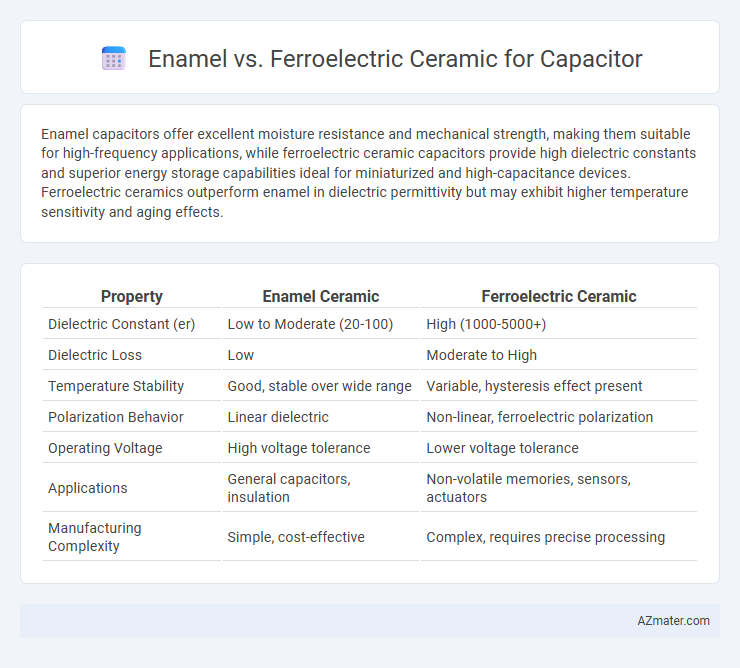Enamel capacitors offer excellent moisture resistance and mechanical strength, making them suitable for high-frequency applications, while ferroelectric ceramic capacitors provide high dielectric constants and superior energy storage capabilities ideal for miniaturized and high-capacitance devices. Ferroelectric ceramics outperform enamel in dielectric permittivity but may exhibit higher temperature sensitivity and aging effects.
Table of Comparison
| Property | Enamel Ceramic | Ferroelectric Ceramic |
|---|---|---|
| Dielectric Constant (er) | Low to Moderate (20-100) | High (1000-5000+) |
| Dielectric Loss | Low | Moderate to High |
| Temperature Stability | Good, stable over wide range | Variable, hysteresis effect present |
| Polarization Behavior | Linear dielectric | Non-linear, ferroelectric polarization |
| Operating Voltage | High voltage tolerance | Lower voltage tolerance |
| Applications | General capacitors, insulation | Non-volatile memories, sensors, actuators |
| Manufacturing Complexity | Simple, cost-effective | Complex, requires precise processing |
Introduction to Capacitor Dielectric Materials
Capacitor dielectric materials such as enamel and ferroelectric ceramics significantly influence capacitor performance by determining parameters like dielectric constant, breakdown voltage, and temperature stability. Enamel dielectrics offer moderate permittivity and excellent mechanical robustness, making them suitable for general-purpose capacitors and harsh environments. Ferroelectric ceramic dielectrics provide exceptionally high dielectric constants and tunable polarization properties, enhancing capacitance density and enabling applications in multilayer ceramic capacitors (MLCCs) and advanced electronics.
Overview of Enamel as a Capacitor Dielectric
Enamel as a capacitor dielectric offers high insulation resistance and excellent thermal stability, making it suitable for applications requiring reliable performance in harsh environments. Its glassy, non-porous nature provides robust protection against moisture and chemical exposure, enhancing capacitor longevity. Enamel-coated capacitors typically exhibit stable capacitance and low dielectric loss, which ensures efficient energy storage and minimal signal distortion.
Fundamentals of Ferroelectric Ceramic Dielectrics
Ferroelectric ceramic dielectrics, such as barium titanate, exhibit spontaneous polarization and a high dielectric constant, making them ideal for capacitors requiring high energy storage and tunability. Unlike enamel dielectrics, ferroelectric ceramics operate based on domain switching mechanisms that enable enhanced permittivity and nonlinear dielectric behavior in response to electric fields. These fundamental properties of ferroelectric ceramics allow for superior performance in applications like multilayer ceramic capacitors (MLCCs) and tunable devices compared to traditional enamel-insulated capacitors.
Key Differences: Enamel vs Ferroelectric Ceramic
Enamel capacitors feature a thin insulating enamel coating that provides excellent moisture resistance and stability, making them ideal for high-frequency applications and general-purpose use. Ferroelectric ceramic capacitors utilize a ferroelectric material as the dielectric, offering high dielectric constants and substantial capacitance in compact sizes, but they exhibit higher losses and temperature sensitivity. The key differences include enamel capacitors' superior durability and lower capacitance density versus ferroelectric ceramics' enhanced dielectric properties and miniaturization capabilities.
Dielectric Constant Comparison
Enamel capacitors typically exhibit a lower dielectric constant, usually ranging between 6 to 10, resulting in lower capacitance values and limited frequency stability. Ferroelectric ceramics, such as lead zirconate titanate (PZT), demonstrate significantly higher dielectric constants often exceeding 1000, enabling higher capacitance in compact sizes and improved energy storage capability. The stark contrast in dielectric constants directly influences the capacitor's efficiency, frequency response, and applicability in high-performance electronic circuits.
Electrical Performance and Efficiency
Ferroelectric ceramics exhibit higher dielectric constants and lower losses than enamel capacitors, resulting in superior energy storage and faster response times. Enamel capacitors, made with a thin insulating layer over metal conductors, generally provide better stability and reliability under varying environmental conditions. The superior electrical performance of ferroelectric ceramics makes them ideal for high-frequency and precision applications, while enamel capacitors excel in durability and simple energy filtering tasks.
Stability and Reliability in Applications
Ferroelectric ceramic capacitors exhibit superior dielectric stability under varying temperature and electric field conditions compared to enamel capacitors, making them highly reliable for precision applications. The intrinsic polarization properties of ferroelectric materials enable consistent capacitance and low loss tangent over extended operating cycles, enhancing long-term performance. Enamel capacitors, while cost-effective, typically suffer from higher variability and degradation under thermal and mechanical stress, limiting their reliability in demanding environments.
Cost and Manufacturing Considerations
Enamel capacitors generally offer lower production costs due to simpler manufacturing processes and widely available materials compared to ferroelectric ceramic capacitors, which require specialized fabrication techniques and high-purity ceramic powders. Ferroelectric ceramic capacitors provide superior dielectric properties and temperature stability but incur higher costs from complex sintering procedures and stringent quality controls. The choice between the two depends on budget constraints and performance requirements, with enamel capacitors favored for cost-sensitive mass production and ferroelectric ceramics selected for high-performance, precision applications.
Suitability for Modern Electronic Devices
Enamel capacitors offer excellent insulation and low cost, making them suitable for vintage or low-frequency electronic applications but lack the high dielectric constant and temperature stability required for modern devices. Ferroelectric ceramic capacitors deliver superior capacitance density, high dielectric permittivity, and excellent temperature stability, essential for advanced electronics such as smartphones, automotive systems, and IoT devices. The ferroelectric ceramic's ability to maintain performance under varying electrical and environmental conditions makes it the preferred choice for contemporary high-performance capacitors.
Conclusion: Choosing the Best Dielectric Material
Enamel capacitors offer excellent insulation and stability for low-frequency applications, while ferroelectric ceramics provide higher permittivity and better performance in high-frequency, high-capacitance scenarios. Selecting the ideal dielectric material depends on factors such as dielectric constant, temperature stability, and voltage rating tailored to the specific electronic application. Ferroelectric ceramics are generally preferred for advanced capacitors demanding compact size and superior energy storage, whereas enamel capacitors remain suitable for cost-effective, robust designs.

Infographic: Enamel vs Ferroelectric Ceramic for Capacitor
 azmater.com
azmater.com